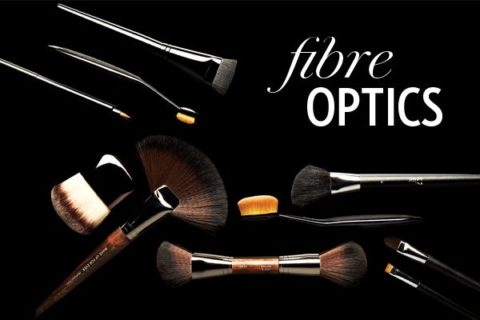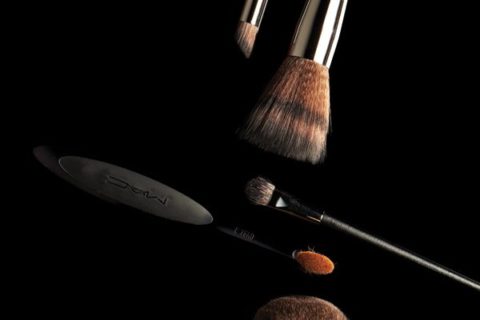Best makeup brushes: Illamasqua, M.A.C and Make Up For Ever all have new and improved offerings for fall


New bristle technology and ergonomically designed brushes are changing the way we put on makeup. Time to toss those sponge-tip applicators.
There’s a plastic skull at the offices of British makeup brand Illamasqua. It’s neither paperweight nor homage to Alexander McQueen: It belongs to David Horne, the director of product development, who studies the model cranium when he’s designing makeup brushes to help him determine what shapes fit best with the bone structure of the face. “That’s where I start,” he says. “I think, ‘Where is this brush going to go?’” Most recently, Horne used the anatomy class teaching aid while developing the Blush Up Brush ($50, thebay.com), focusing on the spot “where the mandible connects with the zygomatic.” The result: densely packed bristles arranged in an oval shape that deposit and blend pigment better than the traditional lollipop silhouette, he says, because they fit in the natural groove below the cheekbone. “If you change the tools, you change the application by default.”
Beauty brands are launching new and improved brushes on the regular, making us rethink tried and true application techniques. M.A.C’s latest offering, a trio of wands out this November (from $30, maccosmetics.com), made their debut as prototypes at the Spring and Fall 2013 shows. Their unconventional shape—they bear a striking resemblance to travel-size toothbrushes—stopped traffic backstage. “A model grabbed my wrist and said, ‘What is that?’” recalls Gordon Espinet, vice-president of global artist training, development and makeup artistry at M.A.C. “She said, ‘That’s the weirdest-looking powder brush I’ve ever seen.’” He sees the new design as a boon for novices because wielding one feels familiar, like a hairbrush. “I was watching a woman on the subway, putting on her makeup. I wanted to say to her, ‘The 1200s called, and they want their sponge-tip applicator back.’ There are still a lot of people who aren’t comfortable with brushes.”
Most artists agree that the right brushes can actually compensate for poor technique. “You can’t do great makeup without great brushes,” says Sonia Kashuk, whose namesake line (from $2, at Target) has nary a sponge tip and places a big focus on brushes, which is unusual for a mass brand. For professional makeup artists like Kashuk, application is just as important—sometimes more so—as the product being applied.
The relationship between face painters and their tools is not unlike that between an illustrator and her carefully organized pencils, or an outfielder and his lucky, broken-in baseball glove. Dick Page remembers his first brush set from Littlewoods, an English mail order catalogue: “I got them for my birthday and used them until they disintegrated.” Espinet hangs onto brushes that never made it out of the testing phase. “Once I was doing a training session and one of them went missing—I actually locked the door and said, ‘Nobody leaves the room.’”

The diversity and volume of prestige brushes available belie the fact that the bulk of them are handcrafted by artisans at just two companies: Chikuhodo in Japan and France’s Raphaël—both of which began as makers of art brushes. Make Up For Ever turned to Raphaël to develop its 76-strong collection of new brushes (from $21, sephora.ca), masterminded by the brand’s creator, Dany Sanz. “I drew the shapes I wanted, very finished shapes that I had never seen before,” Sanz says. Each wood handle doubles as a “palette knife,” which is to say the bottom is slanted, allowing you to scoop product onto the back of your hand. All are made from artificial fibres: Some feature wavy bristles, which deliver a transparent wash of colour, and some offer straight ones for a stronger helping of pigment. M.A.C’s collection also sprouts the next generation of synthetic fibres. “Once upon a time, we believed that to get the softest quality in a bristle it had to be natural, but technology has changed,” says Espinet. “Now, the synthetic bristles out there are sometimes softer than natural bristles.”
Even with all the advancements in synthetics, many artists still prefer natural fibres, or a combination. “Synthetic is good for sharper edges, for precision,” says Page, who mostly works with “fluffy brushes, and they’re some sort of animal hair.” He favours squirrel, sable and tanooki. Handle length matters to him, too: “I have giant hands so I like a long handle. I like the balance.”
In some cases, a makeup artist’s most effective tools are her own hands. “Fingers are the best brush,” says Sanz. Tom Pecheux used his to blend and press on gloss, lipstick and black cream eyeshadow to create the berry-stained lips at Derek Lam’s Fall 2013 show. “The heat of your lips and the heat of your finger help the texture, [so] it just melts in,” he explained backstage. “I love to work with brushes, but I love working with my fingers. I love to touch and grab.” This preference took root during his previous career as a pastry chef in Paris—he’s known for using those croissant-kneading skills to massage creams, serums and Rodin Olio Lusso Luxury Face Oil into models’ skin. On certain occasions, though, he will enlist only his brushes. “I have noticed through the years that if I don’t like the person, that’s when I use all of my brushes,” he says. “I don’t want to touch them, so the brush is making the connection.”







